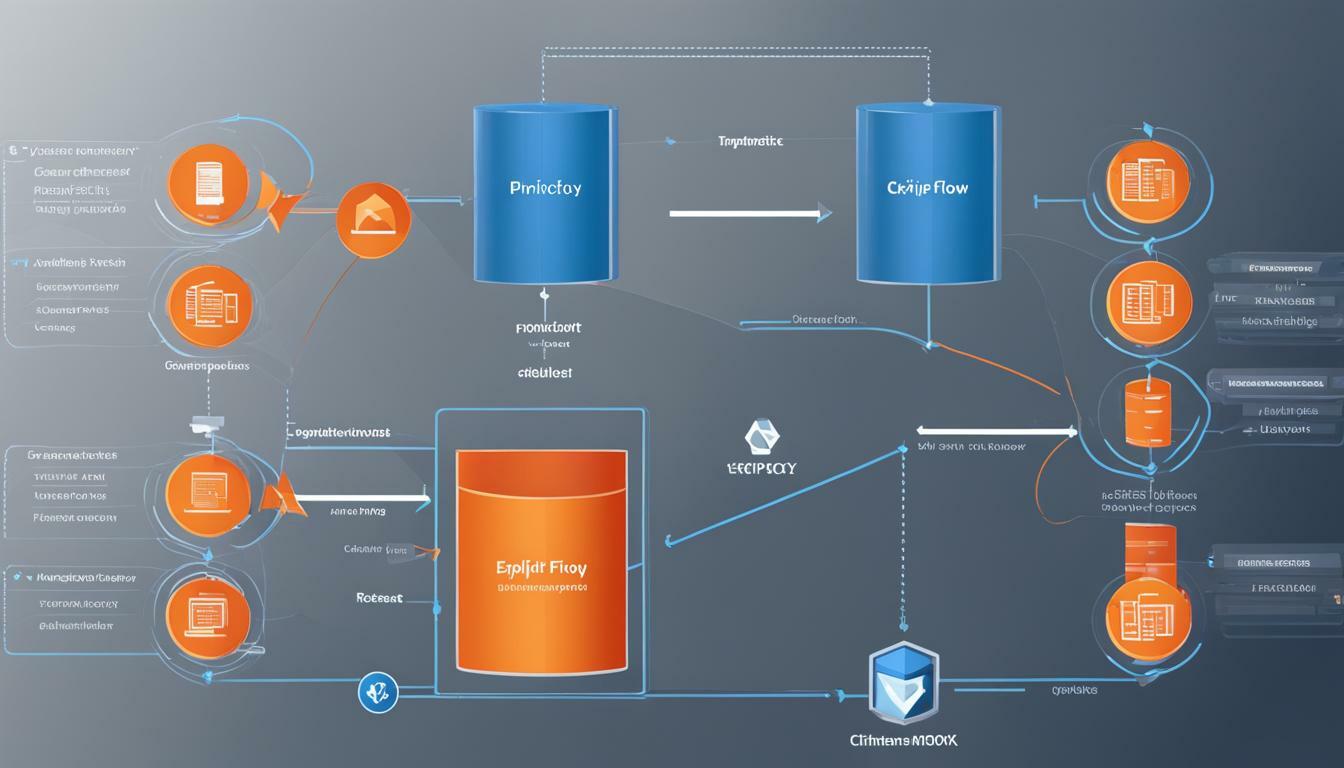In the world of proxies, understanding the differences between transparent proxy and explicit proxy is essential for optimizing network performance and security. Transparent proxies and explicit proxies differ in how traffic is directed to them, with each providing unique benefits and drawbacks. This comprehensive guide will delve into the functions, benefits, and key differences between transparent proxy and explicit proxy, equipping you with the knowledge to make informed decisions regarding your network infrastructure.
Key Takeaways:
- Transparent proxies require no additional client-side configuration and are invisible to clients.
- Explicit proxies require client-side configuration and offer easier troubleshooting.
- Transparent proxies intercept traffic at the network level, while explicit proxies intercept traffic at the application level.
- Transparent proxies may require network redesign, while explicit proxies require minimal network configuration.
- Transparent proxies can intercept the 3-way handshake of any application, while explicit proxies can authenticate all traffic received before interception.
What is a Proxy?
Before diving into the differences between transparent proxy and explicit proxy, it’s important to have a clear understanding of what a proxy is. In the context of network communications, a proxy acts as an intermediary between a client device and a server. It facilitates the exchange of data between the two, enhancing security, performance, and control over network traffic.
A proxy server receives requests from clients and forwards them to the appropriate server. It then retrieves the server’s response and sends it back to the client. This process allows the proxy to intercept, filter, and modify network traffic, providing various functionalities such as caching, content filtering, and load balancing.
Proxies are commonly used in corporate networks to manage and regulate internet access, as well as to enhance security by preventing direct connections between clients and servers. They can also be utilized for anonymous web browsing, as the proxy server masks the client’s IP address.
| Advantages of a Proxy: | Disadvantages of a Proxy: |
|---|---|
| Enhanced security | Additional point of failure |
| Improved performance through caching | Potential slowdown in network traffic |
| Content filtering and access control | Complex configuration and maintenance |
| Load balancing and traffic shaping | Dependency on proxy server availability |
Overall, a proxy can provide numerous benefits in terms of security, performance, and control over network traffic. Understanding the concept and functionalities of a proxy is crucial when comparing and evaluating different types of proxies, such as transparent and explicit proxies.
How Does a Transparent Proxy Work?
Transparent proxies operate by seamlessly intercepting and redirecting network traffic without requiring any additional client-side configuration. Traffic sent by the client application is not aware that it is being directed to a proxy server. The network devices, such as routers or firewalls, are responsible for detecting the traffic and redirecting it to the proxy. From the client’s perspective, there is no difference in terms of Layer 4 and below. The transparent proxy acts as an intermediary, intercepting and forwarding traffic between the client and the destination server.
Unlike explicit proxies, where the client application needs to be configured with the proxy’s IP and port, transparent proxies don’t require such configuration. This makes it easier to deploy and manage in a network environment, as there is no need to make changes on individual client applications. The transparent proxy can intercept and redirect traffic from any application without the need for explicit configuration.
When a client sends a request to a destination server, the transparent proxy intercepts the traffic and examines the packets. It then forwards the packets to the destination server on behalf of the client. Similarly, when the destination server sends a response back to the client, the transparent proxy intercepts the response and forwards it to the client. This interception and redirection happen seamlessly, without the client’s knowledge or involvement in the process.
It’s important to note that transparent proxy deployment may require additional network devices and modifications to the existing network infrastructure. This is because the network needs to be configured to detect and redirect traffic to the transparent proxy. The complexity of this deployment depends on the network architecture and the specific requirements of the transparent proxy implementation.
Transparent Proxy Operation
| Step | Description |
|---|---|
| 1 | The client sends a request to the destination server. |
| 2 | The network device intercepts the traffic and redirects it to the transparent proxy. |
| 3 | The transparent proxy receives the request and forwards it to the destination server. |
| 4 | The destination server processes the request and sends a response back to the transparent proxy. |
| 5 | The transparent proxy intercepts the response and forwards it to the client. |
In summary, transparent proxies operate by intercepting and redirecting network traffic seamlessly without requiring any additional configuration on the client side. This deployment method can provide various benefits, including ease of management and the ability to intercept traffic from any application. However, it may require modifications to the network infrastructure and additional network devices to enable the interception and redirection of traffic to the transparent proxy.
Pros and Cons of Transparent Proxy
Transparent proxies offer several advantages, but they also come with a few potential drawbacks that should be considered. Let’s take a closer look at the pros and cons of using a transparent proxy in a network environment:
| Advantages | Disadvantages |
|---|---|
|
|
In a transparent proxy deployment, the client software is unaware that it is communicating with a proxy, and all client traffic goes through the proxy. The proxy intercepts incoming packets and redirects them to the proxy. The proxy establishes a connection with the origin server and returns requested content to the client. This deployment requires additional network devices and can be more complex to set up and maintain.
On the other hand, explicit proxies also have their own set of pros and cons:
| Advantages | Disadvantages |
|---|---|
|
|
In an explicit proxy deployment, the client software is explicitly configured to use the proxy server. The clients are configured to talk directly to the web filter cluster. This deployment is simpler and requires minimal network configuration.
Web Gateway Considerations
When configuring a web gateway, it is important to prioritize making it highly available by using redundancy and load distribution features. This ensures uninterrupted service and better performance for users accessing the network through the proxy.
Another important consideration is authentication and SSL encryption support in transparent mode. These features enable secure and authenticated communication between clients and the proxy, enhancing network security and protecting sensitive data.
In conclusion, the choice between transparent and explicit proxy deployments depends on the specific network requirements and preferences. It is recommended to consult with a technical architect or consultant experienced with the chosen vendor’s product to ensure the best deployment option is chosen.
How Does an Explicit Proxy Work?
Explicit proxies involve configuring clients to utilize a specific proxy server for their network communications. By configuring the client software to use the proxy server, all client traffic is directed through the proxy, allowing for better control and monitoring of network activity.
When a client makes a request for a web resource, the request is first sent to the configured proxy server. The proxy server then evaluates the request, determines whether to allow or block the requested resource based on defined policies, and forwards the request to the destination server. The destination server responds to the request, and the proxy server relays the response back to the client.
Explicit proxy deployments involve client-side configuration to ensure that all network communications are routed through the designated proxy server. Clients are typically configured with the IP address and port number of the proxy server, allowing them to establish connections and communicate with external servers.
Benefits and Considerations of Explicit Proxy Deployment
Explicit proxy deployments offer several advantages and considerations for network administrators:
- Easier Troubleshooting: With explicit proxies, it is easier to identify and troubleshoot network issues since all traffic passes through the designated proxy server. This allows for better visibility and control over network traffic.
- Enhanced Authentication: Explicit proxies provide the ability to authenticate all traffic before interception, ensuring that only authorized users can access network resources.
- Client-Side Configuration: Clients need to be explicitly configured to use the proxy server, which may require additional steps for setting up and maintaining the network environment.
- User Awareness: Clients are aware of the proxy’s existence and may attempt to bypass it or tunnel traffic through other means. Additional measures may be needed to enforce proxy usage.
- Proxy Responsibilites: In explicit proxy deployments, the proxy server is responsible for completing DNS requests on behalf of all clients, ensuring proper resolution of domain names.
Conclusion:
The choice between transparent and explicit proxy deployments depends on specific network requirements and preferences. Explicit proxies offer the advantage of greater control and monitoring capabilities, with the ability to authenticate and monitor all traffic passing through the proxy server. However, they require client-side configuration and may face challenges with user awareness and potential circumvention attempts. Network administrators should carefully evaluate their needs and consult with technical experts to determine the best proxy deployment approach for their environment.
Pros and Cons of Explicit Proxy
Explicit proxies offer unique benefits and face certain challenges that should be taken into account when considering their implementation. Let’s explore the advantages and disadvantages of using an explicit proxy in a network environment:
Advantages
| Advantage | Description |
|---|---|
| Easier to troubleshoot | Explicit proxies have clear configurations, making it easier to identify and resolve any issues that may arise. |
| Authentication for all traffic | An explicit proxy allows for authentication of all traffic received before interception, enhancing security and control. |
Disadvantages
| Disadvantage | Description |
|---|---|
| Client-side configuration | Explicit proxies require client-side configuration, which can be time-consuming and may require additional user training. |
| Potential bypass attempts | Since clients are aware of the proxy’s existence, they may attempt to bypass it or tunnel traffic through it, creating potential security risks. |
| Proxy responsible for DNS requests | In an explicit proxy deployment, the proxy server is responsible for completing DNS requests on behalf of all clients, potentially leading to increased latency. |
When deploying an explicit proxy, clients need to be explicitly configured to use the proxy server. This simplifies network configuration but requires individual settings on each client. The explicit proxy intercepts incoming packets and redirects them to the proxy, which then establishes a connection with the origin server and returns the requested content to the client.
To ensure the high availability of the web gateway, it is crucial to prioritize redundancy and load distribution features. Additionally, supporting authentication and SSL encryption in transparent mode is essential for a secure explicit proxy deployment.
Ultimately, the choice between transparent and explicit proxy deployments depends on specific network requirements and preferences. It is recommended to consult with a technical architect or consultant experienced with the chosen vendor’s product to determine the most suitable option for your network environment.
Transparent Proxy Deployment
Setting up a transparent proxy requires careful planning and additional network devices to redirect and intercept traffic efficiently. The client software remains unaware that it is communicating with a proxy, and all client traffic passes through the proxy. This allows the proxy to intercept incoming packets and redirect them accordingly. By establishing a connection with the origin server and returning the requested content to the client, the transparent proxy ensures seamless communication.
However, deploying a transparent proxy can be more complex than an explicit proxy setup. It requires the implementation of additional network devices to redirect traffic effectively. This can involve configuring routers or switches to forward network traffic to the proxy server. These devices play a crucial role in ensuring that all client requests are properly intercepted and redirected to the proxy for processing.
To illustrate the deployment process, refer to the table below:
| Network Devices | Function |
|---|---|
| Router | Responsible for forwarding traffic to the proxy server |
| Switch | Facilitates network connectivity and directs traffic to the proxy |
| Firewall | Ensures secure access and filters traffic based on configured rules |
By carefully configuring these network devices, you can ensure that the transparent proxy deployment operates smoothly and efficiently. It is important to consult with experts or technical architects experienced with the chosen vendor’s product to ensure optimal configuration and performance.
Explicit Proxy Deployment
Deploying an explicit proxy is relatively straightforward, with minimal network configuration necessary to ensure smooth operations. The process involves configuring the client software to connect directly to the proxy server, allowing for more control and customization of proxy settings.
One of the advantages of explicit proxy deployment is the ability to troubleshoot and monitor traffic more easily. By explicitly configuring the client-side settings, network administrators can easily identify any issues that may arise and quickly address them. This level of visibility and control can help ensure optimal performance and security.
With explicit proxy deployment, clients are aware of the proxy’s existence and can attempt to bypass it or tunnel traffic through it. However, this can be mitigated by implementing strict security measures and policies to prevent unauthorized bypassing of the proxy. It is essential to educate users about the benefits of using the proxy and the potential risks associated with circumventing it.
Proxy Deployment Best Practices
- Thoroughly test and configure the proxy server to ensure compatibility with the network environment and applications.
- Implement proper access controls and authentication mechanisms to ensure that only authorized users can access the proxy server.
- Regularly monitor and analyze proxy logs to identify any suspicious or abnormal activities.
Example Configuration
Below is a sample configuration for an explicit proxy deployment:
| Proxy Server | IP Address | Port |
|---|---|---|
| Proxy A | 192.168.1.100 | 8080 |
| Proxy B | 192.168.1.101 | 8080 |
In this example, clients are configured to connect to either Proxy A or Proxy B using the specified IP address and port number. The proxy servers are responsible for completing DNS requests on behalf of the clients and intercepting incoming traffic for analysis and filtering.
Web Gateway Considerations
To optimize performance and security, it is crucial to prioritize high availability and employ features like redundancy and load distribution in your web gateway. These considerations ensure that your network infrastructure can handle the demands of internet traffic, while minimizing downtime and providing a seamless user experience.
Redundancy is an essential aspect of any web gateway deployment. By implementing redundant systems, you can ensure that your network remains operational even if one component or server fails. This not only enhances reliability but also minimizes the risk of service interruptions. Redundancy can be achieved through hardware redundancy, where multiple devices are used in parallel, or through software redundancy, where multiple instances of the web gateway are deployed in a cluster.
Load distribution is another critical feature to consider when deploying a web gateway. By distributing incoming network traffic across multiple servers, you can effectively balance the load and prevent any single server from becoming overwhelmed. This ensures optimal performance by allowing each server to handle a manageable amount of traffic. Load distribution can be achieved through various methods, such as round-robin, least connections, or weighted load balancing algorithms.
Web Gateway Features and Functions
A web gateway offers various features and functions that enhance network security and control. These may include:
- URL filtering: Allows you to block or allow specific websites or categories of websites based on predefined policies.
- Malware protection: Scans web traffic for malicious content, such as viruses, Trojans, and spyware, and blocks access to infected sites.
- Application control: Enables you to manage and prioritize network traffic based on the application or protocol being used.
- Bandwidth management: Allows you to allocate and prioritize bandwidth to different users or applications, ensuring optimal network performance.
- SSL inspection: Provides the ability to decrypt and inspect SSL-encrypted traffic, allowing for deeper visibility and control of encrypted communications.
By leveraging these features, a web gateway can effectively protect your network from threats, enforce acceptable use policies, and optimize network performance.
| Pros of Web Gateway | Cons of Web Gateway |
|---|---|
| Enhanced security through URL filtering and malware protection | Initial setup and configuration may require technical expertise |
| Flexible control over network traffic with application control and bandwidth management | Ongoing maintenance and updates are necessary to keep up with evolving threats |
| Ability to inspect SSL-encrypted traffic for deeper visibility and control | Increased network latency due to additional processing required for SSL inspection |
Investing in a robust web gateway solution that incorporates redundancy and load distribution features will help you create a resilient and high-performing network infrastructure. Consider your specific network requirements, the scale of your organization, and the level of control and security you need when choosing the right web gateway solution for your business.
Authentication and SSL Encryption
Ensuring robust authentication and SSL encryption capabilities in transparent proxy deployments is vital for maintaining network security. Authentication allows for the verification of user identities, preventing unauthorized access to network resources and ensuring that only authenticated users can access sensitive information. SSL encryption, on the other hand, provides a secure channel for transmitting data over the network, protecting it from interception and unauthorized access.
When it comes to transparent proxy deployments, authentication and SSL encryption can present unique challenges. In transparent mode, the proxy intercepts and redirects traffic without the need for client-side configuration, making it essential to implement mechanisms that support authentication and SSL encryption seamlessly.
One approach is to configure the transparent proxy to act as a man-in-the-middle, intercepting SSL/TLS traffic and decrypting it before re-encrypting it with a server certificate. This allows the proxy to inspect the decrypted traffic for security purposes, such as malware detection or content filtering, before re-encrypting it and forwarding it to the destination server. This process, known as SSL interception or SSL offloading, requires careful configuration and management to ensure the integrity of the encrypted traffic.
Table 1: Pros and Cons of Authentication and SSL Encryption in Transparent Proxy Deployments
| Pros | Cons |
|---|---|
| Enhanced security by preventing unauthorized access to network resources | Potential performance impact due to the decryption and re-encryption process |
| Ability to inspect decrypted traffic for security purposes, such as malware detection | Possibility of SSL handshake failures or compatibility issues with certain applications |
| Option to enforce stricter security policies, such as requiring client certificate authentication | Increased complexity in managing certificate authorities and ensuring certificate validity |
Deploying authentication and SSL encryption in transparent proxy environments requires careful planning and consideration to strike a balance between security and performance. It is essential to work closely with network administrators and security professionals to determine the most appropriate authentication methods, certificate management practices, and SSL interception policies for your specific network requirements.
Making the Choice: Transparent vs Explicit Proxy
Choosing between transparent proxy and explicit proxy depends on various factors, such as network requirements and individual preferences. Each type of proxy has its own advantages and disadvantages that should be considered when deciding which one to implement.
In a transparent proxy, no additional client-side configuration is needed, and the client is unaware of the proxy’s existence. This can be beneficial as it simplifies the setup process and eliminates the need for client-side changes. However, transparent proxies may require network redesign to redirect traffic, and traffic that needs to bypass SSL interception cannot be authenticated. Additionally, the client is responsible for DNS requests.
On the other hand, an explicit proxy requires client-side configuration, as clients need to be explicitly configured to use the proxy server. While this can add an extra step during setup, it provides more control and allows for the authentication of all traffic received before interception. However, the client is aware of the proxy’s existence and may try to bypass it or tunnel traffic through it. The proxy is also responsible for completing DNS requests on behalf of all clients.
In terms of deployment, transparent proxies require additional network devices and can be more complex to set up and maintain. The client software is unaware that it is communicating with a proxy, and all client traffic goes through the proxy. In an explicit proxy deployment, the clients are explicitly configured to use the proxy server, making the setup simpler and requiring minimal network configuration.
| Transparent Proxy | Explicit Proxy |
|---|---|
|
|
When making a decision between transparent proxy and explicit proxy, it is essential to prioritize network requirements and consider individual preferences. Consulting with a technical architect or consultant experienced with the chosen vendor’s product is recommended to ensure the chosen proxy deployment aligns with the organization’s specific needs.
Conclusion
Understanding the differences and trade-offs between transparent proxy and explicit proxy is essential for making informed decisions regarding network performance and security. Both types of proxies offer distinct advantages and disadvantages that should be carefully considered.
Transparent Proxy
A transparent proxy requires no additional client-side configuration and operates behind the scenes, intercepting network traffic without the client’s knowledge. This can be advantageous as it eliminates the need for client involvement and allows for seamless interception of various applications. However, implementing a transparent proxy may necessitate network redesign and can be more complex to set up and maintain. Additionally, traffic that needs to bypass SSL interception cannot be authenticated, which may pose security concerns. Furthermore, clients are responsible for DNS requests, adding another layer of complexity.
Explicit Proxy
An explicit proxy, on the other hand, requires client-side configuration to direct traffic through the proxy server. Clients are aware of the proxy’s existence and can potentially try to bypass it or tunnel traffic through it. However, this type of proxy is easier to troubleshoot and allows for authentication of all intercepted traffic. The proxy server assumes the responsibility of completing DNS requests on behalf of all clients, relieving clients of this task.
In a transparent proxy deployment, the client software communicates with the proxy unknowingly, while in an explicit proxy deployment, the client software is explicitly configured to use the proxy server. Transparent proxy deployments typically require additional network devices and can be more intricate to set up and maintain. Conversely, explicit proxy deployments involve minimal network configuration and are simpler to implement.
When deploying a web gateway, it is crucial to prioritize high availability by utilizing redundancy and load distribution features. Additionally, support for authentication and SSL encryption in transparent mode is essential for maintaining network security.
In conclusion, the choice between transparent and explicit proxy deployments ultimately depends on specific network requirements and preferences. Consulting with a technical architect or consultant experienced with the chosen vendor’s product is recommended to ensure the most suitable proxy solution is chosen to meet the organization’s needs.








